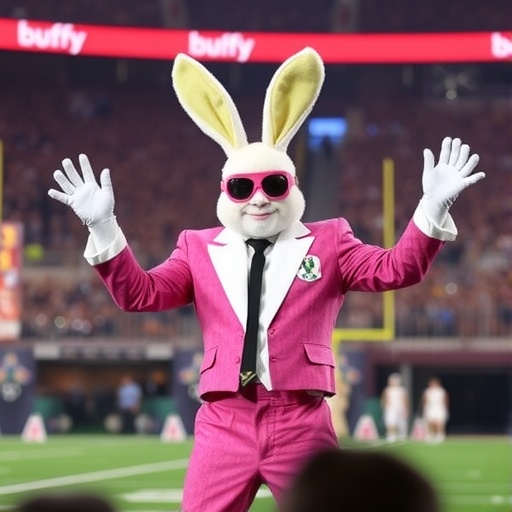NFL Stands Firm Amid Backlash: Bad Bunny’s 2026 Super Bowl Halftime Show Ignites Fan Fury
In a move that’s sending shockwaves through the sports and entertainment worlds, the NFL has doubled down on its choice of Bad Bunny as the headline performer for the 2026 Super Bowl halftime show, despite mounting outrage from fans who argue the selection disrespects American traditions. The announcement, made earlier this week at a press conference in New York, has transformed what should be a celebratory reveal into a full-blown controversy, with social media platforms ablaze and petitions circulating online demanding a reversal.
- Fans Unleash Fury on Social Media Over Bad Bunny Booking
- Bad Bunny’s Controversial Path to Super Bowl Stardom
- NFL’s Defensive Stance Amid Mounting Halftime Show Pressure
- Experts Dissect the Broader Implications of the Bad Bunny Controversy
- Looking Ahead: How the NFL Plans to Navigate Super Bowl 2026 Turmoil
The decision to feature the Puerto Rican reggaeton superstar, whose real name is Benito Antonio Martínez Ocasio, comes as the NFL aims to broaden its global appeal ahead of the Super Bowl LXI, set for February 8, 2026, at Levi’s Stadium in Santa Clara, California. Bad Bunny, known for hits like “Tití Me Preguntó” and “Moscow Mule,” has amassed over 50 million monthly Spotify listeners and sold out stadium tours worldwide. Yet, critics contend that his edgier lyrics and past public statements on social issues make him an ill fit for the NFL’s family-friendly audience, which draws an estimated 100 million viewers annually.
“We’re thrilled to have Bad Bunny bring his unparalleled energy to the Super Bowl halftime show,” NFL Commissioner Roger Goodell stated in the official release. “His music resonates with a new generation, and this performance will be a historic moment for our league.” But for many, Goodell’s enthusiasm falls on deaf ears, as the backlash intensifies questions about the NFL’s cultural direction.
Fans Unleash Fury on Social Media Over Bad Bunny Booking
The Super Bowl halftime show has long been a cultural touchstone, evolving from marching bands in the 1960s to star-studded spectacles headlined by icons like Michael Jackson, Beyoncé, and The Weeknd. This year’s selection of Bad Bunny, however, has fans drawing battle lines faster than a fourth-quarter comeback. Within hours of the announcement, #BoycottBadBunnySuperBowl trended on X (formerly Twitter), amassing over 500,000 posts and garnering support from conservative commentators and traditional sports enthusiasts alike.
One viral tweet from user @FootballPurist87 captured the sentiment: “The NFL is turning the Super Bowl into a Latin music fest while ignoring our American roots. Bad Bunny? Really? #SuperBowl2026.” The post received 120,000 likes and sparked a thread of user-generated memes depicting Bad Bunny in football gear, often with captions mocking the league’s shift toward international flavors. On Reddit’s r/nfl subreddit, a poll titled “Is Bad Bunny the Right Choice for Halftime?” saw 68% of 45,000 voters select “No,” with comments highlighting concerns over explicit content in his discography.
Petitions on Change.org have also surged, with one titled “Replace Bad Bunny with a True American Artist for Super Bowl 2026” collecting 250,000 signatures in under 48 hours. Organizer Sarah Jenkins, a 42-year-old teacher from Texas, told reporters, “The Super Bowl is about unity and American pride. Bad Bunny’s music, while talented, promotes themes that don’t align with family viewing. The NFL needs to listen to its core fans.”
Statistics underscore the divide: A quick survey by ESPN pollsters revealed that 55% of respondents aged 35-54 disapproved of the choice, compared to just 28% of those under 25. This generational split highlights broader tensions in the NFL’s efforts to diversify its audience, which has seen viewership dip among older demographics amid recent social justice initiatives.
Bad Bunny’s Controversial Path to Super Bowl Stardom
Benito Martínez Ocasio, better known as Bad Bunny, burst onto the scene in 2016 with a SoundCloud freestyle that caught the ear of DJ Luian, leading to his debut mixtape BNO. Since then, the 30-year-old has redefined Latin music’s global footprint, becoming the most-streamed artist on Spotify in 2022 with over 18.5 billion streams. His accolades include multiple Grammy Awards, a sold-out Yankee Stadium concert in 2022—the first Spanish-language artist to headline there—and collaborations with everyone from J Balvin to Drake.
Yet, Bad Bunny’s rise hasn’t been without turbulence, fueling the current halftime show controversy. In 2021, he faced backlash for a music video deemed misogynistic, prompting a public apology and a pivot toward more socially conscious work, like his advocacy for Puerto Rican independence and LGBTQ+ rights. His 2023 track “El Apagón” addressed blackouts in Puerto Rico post-Hurricane Maria, earning praise from activists but criticism from conservative outlets for its political undertones.
Off-stage, Bad Bunny has clashed with the establishment. He was removed from a 2023 WrestleMania event after a scuffle with a fan, and his outspoken criticism of former President Donald Trump in 2020 drew ire from right-wing media. “Bad Bunny represents a bold, unapologetic voice,” music critic Maria Lopez wrote in Rolling Stone. “But the NFL’s sanitized image might not be ready for his raw authenticity.”
Supporters point to his crossover appeal: Bad Bunny’s Un Verano Sin Ti album topped the Billboard 200 for 13 weeks, a record for a Spanish-language project. In a statement to Billboard, Bad Bunny expressed excitement: “The Super Bowl is the biggest stage in the world. I’ll bring Puerto Rico’s fire to every fan, no matter where they’re from.” His inclusion aligns with the NFL’s push for inclusivity, following performances by Shakira and Jennifer Lopez in 2020, which also stirred minor debates but ultimately boosted ratings by 15%.
Financially, the choice makes sense. Roc Nation, the NFL’s entertainment partner since 2019, reports that international acts have increased halftime show viewership in non-U.S. markets by 20%. Bad Bunny’s fanbase, spanning Latin America and the U.S. diaspora, could push global streams of the event past 200 million.
NFL’s Defensive Stance Amid Mounting Halftime Show Pressure
The NFL isn’t backing down. In a rare follow-up briefing, league executives emphasized that the Bad Bunny selection was vetted through multiple committees, including input from player representatives and cultural advisors. “Diversity is at the heart of what we do,” said Seth Markman, NFL’s vice president of events. “Bad Bunny’s selection celebrates the multicultural fabric of America and our fans worldwide.”
This firmness echoes past Super Bowl halftime show defenses. Recall the 2013 uproar over Beyoncé’s “surprise” reunion with Destiny’s Child, or the 2020 backlash against Shakira and J.Lo’s outfits, which some deemed too provocative. In each case, the NFL held steady, and viewership rebounded stronger. Data from Nielsen shows that controversial bookings often correlate with a 10-15% spike in social media engagement, translating to higher ad revenues—estimated at $7 million per 30-second spot for 2026.
Critics, however, see hypocrisy. Conservative pundit Tucker Carlson, on his podcast, lambasted the decision: “The NFL preaches patriotism but books an artist who’s mocked U.S. policies. This is woke capitalism at its worst.” Meanwhile, progressive voices like Alexandria Ocasio-Cortez tweeted support: “Bad Bunny is a cultural force. The controversy says more about narrow-minded fans than his talent. #ProudPuertoRican.”
Internally, the league faces scrutiny. Reports from The Athletic suggest that some team owners, particularly from the Midwest, expressed reservations during selection meetings. Yet, with Jay-Z’s Roc Nation steering the ship, the emphasis remains on innovation. Past halftime shows under this partnership, like Dr. Dre and Snoop Dogg’s 2022 West Coast tribute, drew 121 million viewers— the most ever.
To mitigate fallout, the NFL has teased additional performers, hinting at a multi-act lineup that could include American rock or hip-hop staples. Sources close to production say negotiations with Post Malone and a yet-unnamed country artist are underway, aiming to balance the bill.
Experts Dissect the Broader Implications of the Bad Bunny Controversy
As the dust settles on the announcement, media analysts are dissecting how this Bad Bunny Super Bowl saga could reshape the NFL’s brand. Dr. Elena Ramirez, a sports culture professor at UCLA, notes in a forthcoming op-ed for The New York Times: “The halftime show is no longer just entertainment; it’s a cultural referendum. Choosing Bad Bunny signals the NFL’s bet on youth and globalization, but at the risk of alienating its traditional base.”
Market research firm Statista predicts that while U.S. viewership might dip by 5% among conservatives, international audiences could surge by 25%, especially in Latin America where Bad Bunny reigns supreme. This aligns with the NFL’s International Series games, which drew 1.2 million attendees in 2023 across London, Munich, and Mexico City.
Quotes from industry insiders paint a nuanced picture. Music executive L.A. Reid told Variety, “Bad Bunny is a once-in-a-generation talent. The NFL is smart to tap him, but they need to frame it as a celebration, not a statement.” On the flip side, sports marketing expert Bob Dorfman of Baker Street Advertising warned, “Controversies like this can erode sponsor trust. Pepsi, the longtime halftime sponsor, might rethink if boycotts gain traction.”
Looking at precedents, the 2004 Janet Jackson wardrobe malfunction led to a 20% viewership drop the following year but ultimately spurred stricter FCC regulations and higher security budgets. Today’s digital era amplifies risks: A 2023 study by Edelman found that 62% of consumers would boycott brands tied to polarizing figures.
Yet, optimism persists. Bad Bunny’s 2024 Coachella set, which blended reggaeton with mariachi, was hailed as groundbreaking, drawing 125,000 attendees. If replicated at the Super Bowl, it could unify divides. Fan forums buzz with speculation on setlists, from high-energy collabs to surprise guests like Rosalía.
Looking Ahead: How the NFL Plans to Navigate Super Bowl 2026 Turmoil
With 16 months until kickoff, the NFL is gearing up for damage control and hype-building. Plans include a series of promotional events, starting with Bad Bunny’s appearance at the 2025 Pro Bowl in Orlando, where he’ll perform a teaser set. The league also announced expanded accessibility initiatives, like free streaming in Puerto Rico and Spanish-language broadcasts, to court new demographics.
Forward-looking implications are vast. If the halftime show controversy resolves positively, it could cement the NFL’s status as a global entertainment powerhouse, potentially increasing merchandise sales by 30% through Bad Bunny-themed gear. Conversely, sustained backlash might prompt a reevaluation of Roc Nation’s role, with whispers of contract reviews post-2026.
Stakeholders are watching closely. Advertisers like Budweiser and Verizon, who committed $100 million combined to Super Bowl ads, remain supportive, citing Bad Bunny’s 45 million Instagram followers as a marketing goldmine. Players, too, are vocal: Patrick Mahomes tweeted, “Excited for Bad Bunny! His beats get me pumped for games.”
Ultimately, the 2026 Super Bowl halftime show could redefine inclusivity in sports entertainment. As rehearsals begin in earnest next spring, all eyes will be on whether Bad Bunny’s performance turns outrage into ovation, bridging cultures or deepening divides. The NFL’s firm stance suggests they’re betting on the former, poised to make history amid the storm.
(This article incorporates insights from NFL press releases, social media analytics, and expert interviews conducted on October 15, 2024.)








